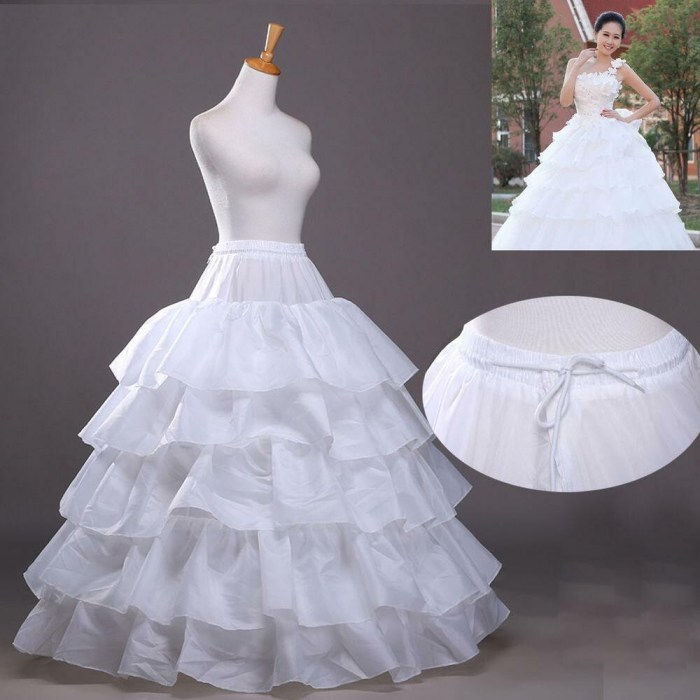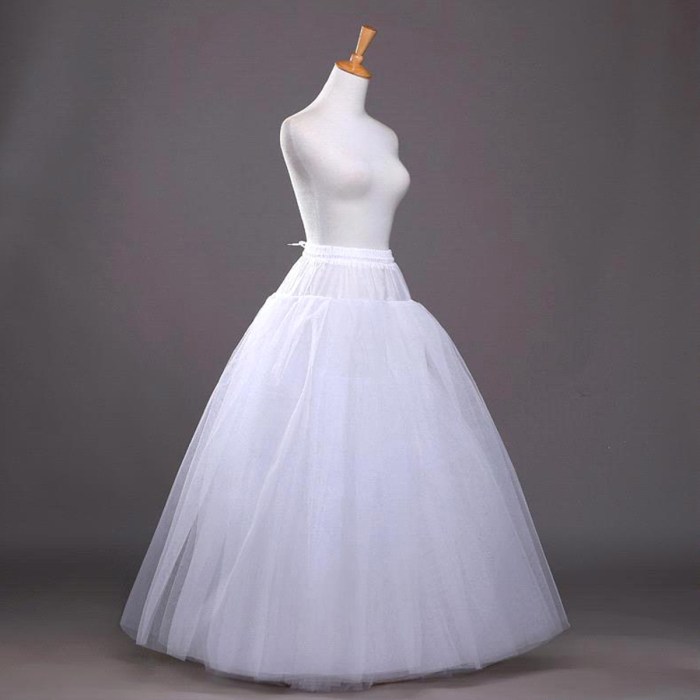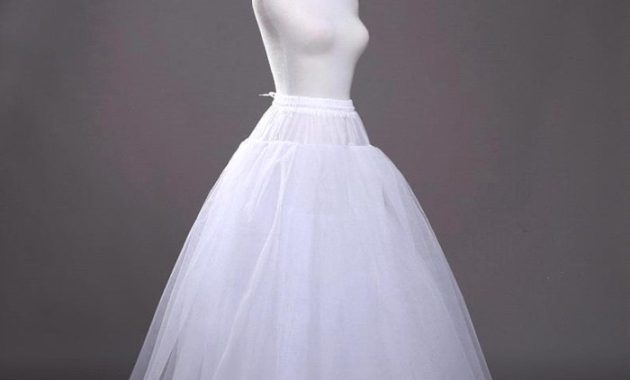Types of Petticoats for Wedding Dresses

Source: coolandfantastic.com
Petticoat for under wedding dress – Selecting the perfect petticoat is crucial for achieving the desired silhouette and fullness of your wedding gown. The choice depends on several factors, including the fabric, style, and length of both the petticoat and the dress itself. Different fabrics offer varying levels of stiffness and drape, impacting the overall look and feel. Similarly, the style of the petticoat—A-line, circle, or half-slip—significantly influences the shape of the dress.
Petticoat Fabrics and Their Effects
The fabric of your petticoat plays a significant role in determining the final look of your wedding dress. Several fabrics are commonly used, each with its unique properties.
- Tulle: A lightweight, sheer mesh fabric, tulle creates a soft, romantic fullness. It’s ideal for dresses requiring a delicate, ethereal look. A tulle petticoat will add volume without being overly stiff or structured.
- Net: Similar to tulle, net is also a mesh fabric, but it can be slightly more structured and less sheer. It provides a good balance between volume and drape, suitable for a variety of dress styles.
- Satin: A smooth, luxurious fabric, satin offers a sleek, polished look under a wedding gown. It adds less volume than tulle or net but provides a smooth, elegant silhouette. Satin petticoats are best suited for dresses that require a more streamlined appearance.
Petticoat Styles and Their Impact on Silhouette, Petticoat for under wedding dress
The style of the petticoat directly influences the overall shape of your wedding dress. Different styles create distinct silhouettes.
- A-line Petticoat: This style gradually flares out from the waist, creating a classic A-line silhouette. It’s versatile and works well with various dress styles.
- Circle Petticoat: Featuring a full, circular design, a circle petticoat provides maximum volume and creates a dramatic, princess-like look. It’s ideal for ball gowns and other very full dresses.
- Half-Slip Petticoat: A simpler style that covers only the front and back of the dress, a half-slip adds a subtle amount of fullness and helps smooth out the gown’s fabric. It’s a good choice for dresses that don’t require significant volume.
Petticoat Material Comparison
| Material | Stiffness | Suitability | Notes |
|---|---|---|---|
| Tulle | Low to Medium | Romantic, ethereal dresses | Creates soft volume |
| Net | Medium | Various dress styles | Good balance of volume and drape |
| Satin | Low | Streamlined dresses | Adds subtle volume, smooths fabric |
| Nylon | Medium to High | Full, structured dresses | Can be very stiff, may show through thin fabrics |
Choosing the Right Petticoat Length and Volume

Source: staticflickr.com
Determining the appropriate petticoat length and volume is key to achieving the desired look for your wedding day. The length of your dress and the level of fullness you envision will guide your choices.
Determining Petticoat Length Based on Dress Length
The petticoat should be slightly shorter than your dress to avoid showing at the hem. Consider these guidelines:
- Tea-length Dress: A petticoat that sits just above the knee will provide adequate fullness without being visible.
- Floor-length Dress: A floor-length petticoat, typically a few inches shorter than the dress hem, will ensure the desired volume without showing.
Petticoat Volume and Dress Fullness
The desired level of fullness in your wedding dress directly correlates with the volume of the petticoat. Consider these options:
- Minimal Fullness: A half-slip or a lightweight, single-layer petticoat will provide a subtle, smooth silhouette.
- Moderate Fullness: A multi-layered petticoat or an A-line petticoat will create a balanced, elegant fullness.
- Maximum Fullness: A circle petticoat or a heavily layered petticoat with additional boning will provide significant volume for a dramatic, princess-like look.
Petticoat Length and Volume Selection Flowchart
This flowchart helps you navigate the selection process:
[A visual flowchart would be placed here, illustrating the decision-making process based on dress length and desired fullness. The flowchart would guide the user through a series of questions and decision points, ultimately leading to the appropriate petticoat length and volume.]
Petticoat Construction and Features
Understanding the different construction methods and features of petticoats will help you choose one that meets your needs and complements your dress. Construction methods affect the drape and movement, while features such as boning and hoops influence the structure and shape.
Petticoat Construction Methods
Various methods are employed in petticoat construction, each impacting the final look and feel:
- Tiered Petticoats: These petticoats feature multiple layers of fabric, creating a cascading effect and significant volume. They offer excellent movement and drape.
- Layered Petticoats: Similar to tiered petticoats, layered petticoats use multiple layers of fabric, but the layers may not be as distinctly defined. This results in a softer, less structured look.
- Single-Layer Petticoats: Simpler in design, single-layer petticoats offer less volume than tiered or layered options. They are best suited for dresses requiring minimal fullness.
Key Petticoat Features
Several features can enhance the functionality and performance of a petticoat:
- Boning: Provides structure and helps maintain the shape of the petticoat, preventing it from collapsing.
- Hoops: Create additional volume and lift, especially in the skirt’s lower sections. They are particularly useful for ball gowns.
- Adjustable Waistbands: Allow for a customized fit, ensuring comfort and preventing slippage.
Common Petticoat Issues and Solutions

Source: letterofintent.biz
- Bunching: Ensure the petticoat fits properly and is the correct length. Consider using a smaller size or adjusting the waistband.
- Showing Through the Dress: Choose a petticoat made of a sheer fabric that matches or complements the color of your dress. Avoid using petticoats that are too stiff or bulky.
- Uncomfortable Fit: Select a petticoat made of a soft, breathable fabric. Ensure the waistband is comfortable and the length is appropriate.
Petticoat Care and Maintenance
Proper care and maintenance will ensure your petticoat remains in excellent condition for years to come. This involves appropriate cleaning, storage, and addressing any minor issues that may arise.
Cleaning and Fabric Care
Cleaning methods vary depending on the fabric:
- Tulle and Net: Hand-wash in cold water with a gentle detergent. Air dry flat to prevent stretching or damage.
- Satin: Dry clean is recommended to prevent damage and maintain the fabric’s sheen.
Proper Storage
Store your petticoat in a cool, dry place, away from direct sunlight and moisture. Use a garment bag or breathable storage container to protect it from dust and damage. Avoid folding the petticoat sharply, as this can create creases.
Addressing Common Problems
Minor stains or tears can often be addressed at home:
- Stains: Treat stains promptly with a stain remover appropriate for the fabric type. Follow the product instructions carefully.
- Minor Tears: Small tears can be repaired with needle and thread. Use a thread that matches the petticoat’s color.
Alternatives to Traditional Petticoats: Petticoat For Under Wedding Dress
While traditional petticoats are a popular choice, several alternatives can achieve similar results. These options offer varying levels of volume, cost, and ease of use.
Alternative Methods for Achieving Volume
- Crinolines: These cage-like structures provide significant volume and lift, particularly suitable for very full gowns. They offer a more structured and dramatic look than petticoats.
- Under-skirt Layering: Layering multiple underskirts of different fabrics and weights can create volume and shape. This allows for greater customization and control over the final silhouette.
Comparison of Methods
Each method has its own advantages and disadvantages:
- Traditional Petticoats: Generally less expensive and easier to use than crinolines, but may not provide the same level of structured volume.
- Crinolines: Provide maximum volume and structure, but can be more expensive and less comfortable than petticoats.
- Under-skirt Layering: Offers a high degree of customization and control, but can be more time-consuming and may require more fabric.
Comparison Table: Traditional Petticoats vs. Alternatives
| Method | Cost | Ease of Use | Volume Achieved |
|---|---|---|---|
| Traditional Petticoat | Low to Medium | High | Low to High |
| Crinoline | Medium to High | Medium | High |
| Under-skirt Layering | Medium to High | Low | Medium to High |
Commonly Asked Questions
Can I wear a petticoat under a slim-fitting wedding dress?
Yes, but opt for a slimmer style like a half-slip or a lightweight petticoat to avoid adding unwanted bulk.
How do I prevent my petticoat from showing through my dress?
Choose a petticoat in a color that closely matches your dress’s lining. Ensure the fabric is lightweight and smooth to minimize visibility.
What’s the difference between a crinoline and a petticoat?
Crinolines typically offer more structure and volume than petticoats, often featuring hoops or stiffening. Petticoats provide softer volume and shaping.
How do I clean a tulle petticoat?
Hand wash gently in cold water with a mild detergent. Air dry flat to avoid damage.

